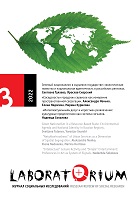"Соседскость" городских сервисов как измерение пространственной сегрегации
“Neighborhoodness” of Urban Services as a Dimension of Spatial Segregation
Author(s): Aleksandra Nenko, Elena Nedoseka, Marina KurilovaSubject(s): Rural and urban sociology
Published by: Центр независимых социологических исследований (ЦНСИ)
Keywords: Spatial Segregation; Neighborhood; Urban Services; Neighboring Online Community; Quality of Urban Environment;
Summary/Abstract: The article considers the quality of neighborhood services available to local residents as a dimension of perceived spatial segregation. The concept of “neighborhoodness” of services targets evaluation of local amenities as demanded by neighbors and positively assessed as satisfying their daily needs. The study addresses the gap in neighborhood services studies, mostly focused on service accessibility and variety and their impact on housing and land value, but paying little attention to both perceived quality and available accessibility of services at the neighborhood level. We argue that two types of neighborhood services should be distinguished: local services aimed at residents and services physically localized in the neighborhood but aimed at external user groups. The research methodology is based on consideration of the subjective and objective dimensions of the neighborhood services by comparing data on objective availability of services and subjective data on perceived accessibility of services taken from neighbors’ discussions. Two online neighborhood communities localized in a historical and in a new housing areas of Saint Petersburg, Russia, are considered, each covering more than 9,000 participants regularly conversing about their neighborhoods. The analysis of the objective availability of services covers typology and user quality metrics of venues within the selected pedestrian boundaries presented in Google Maps. The analysis of the perception of services is based on a semiautomated analysis of semantic fields of “service” concepts such as restaurant, café, store, qualitatively identified as intensively discussed in the communities. Eventually specific patterns of service-related neighborhood-level segregation in historical and new housing urban zones are identified and addressed with recommendations on service development.
Journal: Laboratorium. Журнал социальных исследований
- Issue Year: 14/2022
- Issue No: 3
- Page Range: 34-58
- Page Count: 25
- Language: Russian

